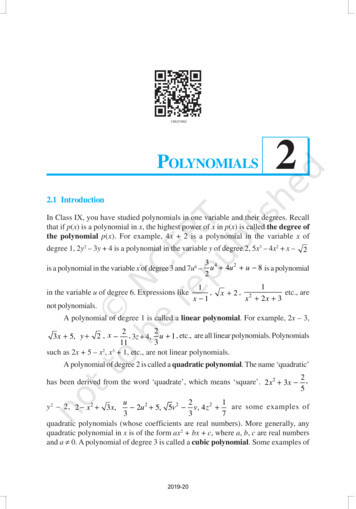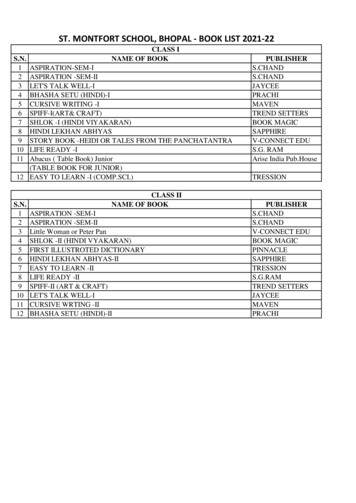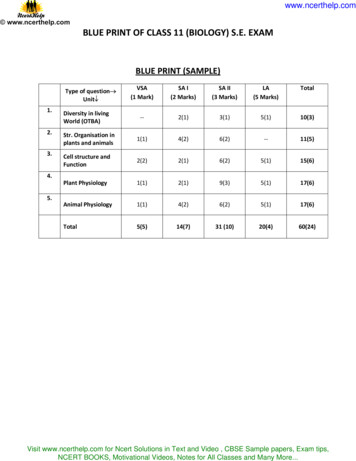
Transcription
20MATHEMATICSPOLYNOMIALS22.1 IntroductionIn Class IX, you have studied polynomials in one variable and their degrees. Recallthat if p(x) is a polynomial in x, the highest power of x in p(x) is called the degree ofthe polynomial p(x). For example, 4x 2 is a polynomial in the variable x ofdegree 1, 2y2 – 3y 4 is a polynomial in the variable y of degree 2, 5x3 – 4x2 x –is a polynomial in the variable x of degree 3 and 7u6 –in the variable u of degree 6. Expressions like23 4u 4u 2 u 8 is a polynomial21,x 1x 2,1etc., arex 2x 32not polynomials.A polynomial of degree 1 is called a linear polynomial. For example, 2x – 3,222 , x , 3z 4, u 1 , etc., are all linear polynomials. Polynomials31123such as 2x 5 – x , x 1, etc., are not linear polynomials.3 x 5, y A polynomial of degree 2 is called a quadratic polynomial. The name ‘quadratic’has been derived from the word ‘quadrate’, which means ‘square’. 2 x 2 3x 2,5u21are some examples of 2u 2 5, 5v 2 v, 4 z 2 337quadratic polynomials (whose coefficients are real numbers). More generally, anyquadratic polynomial in x is of the form ax2 bx c, where a, b, c are real numbersand a 0. A polynomial of degree 3 is called a cubic polynomial. Some examples ofy 2 – 2, 2 x 2 3 x,2019-20
POLYNOMIALS21a cubic polynomial are 2 – x3, x3, 2 x3 , 3 – x2 x3, 3x3 – 2x2 x – 1. In fact, the mostgeneral form of a cubic polynomial isax3 bx2 cx d,where, a, b, c, d are real numbers and a 0.Now consider the polynomial p(x) x2 – 3x – 4. Then, putting x 2 in thepolynomial, we get p(2) 22 – 3 2 – 4 – 6. The value ‘– 6’, obtained by replacingx by 2 in x2 – 3x – 4, is the value of x2 – 3x – 4 at x 2. Similarly, p(0) is the value ofp(x) at x 0, which is – 4.If p(x) is a polynomial in x, and if k is any real number, then the value obtained byreplacing x by k in p(x), is called the value of p(x) at x k, and is denoted by p(k).What is the value of p(x) x2 –3x – 4 at x –1? We have :p(–1) (–1)2 –{3 (–1)} – 4 0Also, note thatp(4) 42 – (3 4) – 4 0.As p(–1) 0 and p(4) 0, –1 and 4 are called the zeroes of the quadraticpolynomial x2 – 3x – 4. More generally, a real number k is said to be a zero of apolynomial p(x), if p(k) 0.You have already studied in Class IX, how to find the zeroes of a linearpolynomial. For example, if k is a zero of p(x) 2x 3, then p(k) 0 gives us32k 3 0, i.e., k 2 b In general, if k is a zero of p(x) ax b, then p(k) ak b 0, i.e., k a b (Constant term)So, the zero of the linear polynomial ax b is. aCoefficient of xThus, the zero of a linear polynomial is related to its coefficients. Does thishappen in the case of other polynomials too? For example, are the zeroes of a quadraticpolynomial also related to its coefficients?In this chapter, we will try to answer these questions. We will also study thedivision algorithm for polynomials.2.2 Geometrical Meaning of the Zeroes of a PolynomialYou know that a real number k is a zero of the polynomial p(x) if p(k) 0. But whyare the zeroes of a polynomial so important? To answer this, first we will see thegeometrical representations of linear and quadratic polynomials and the geometricalmeaning of their zeroes.2019-20
22MATHEMATICSConsider first a linear polynomial ax b, a 0. You have studied in Class IX that thegraph of y ax b is a straight line. For example, the graph of y 2x 3 is a straightline passing through the points (– 2, –1) and (2, 7).x–22y 2x 3–17From Fig. 2.1, you can seethat the graph of y 2x 3intersects the x - axis mid-waybetween x –1 and x – 2,3that is, at the point , 0 . 2 You also know that the zero of32x 3 is . Thus, the zero of2the polynomial 2x 3 is thex-coordinate of the point where theFig. 2.1graph of y 2x 3 intersects thex-axis.In general, for a linear polynomial ax b, a 0, the graph of y ax b is a b straight line which intersects the x-axis at exactly one point, namely, , 0 . a Therefore, the linear polynomial ax b, a 0, has exactly one zero, namely, thex-coordinate of the point where the graph of y ax b intersects the x-axis.Now, let us look for the geometrical meaning of a zero of a quadratic polynomial.Consider the quadratic polynomial x2 – 3x – 4. Let us see what the graph* ofy x2 – 3x – 4 looks like. Let us list a few values of y x2 – 3x – 4 corresponding toa few values for x as given in Table 2.1.* Plotting of graphs of quadratic or cubic polynomials is not meant to be done by the students,nor is to be evaluated.2019-20
POLYNOMIALS23Table 2.1xy x2 – 3x – 4–2–101234560–4–6–6–406If we locate the points listedabove on a graph paper and drawthe graph, it will actually look likethe one given in Fig. 2.2.In fact, for any quadraticpolynomial ax2 bx c, a 0, thegraph of the correspondingequation y ax2 bx c has oneof the two shapes either openupwards likeor opendownwards likedepending onwhether a 0 or a 0. (Thesecurves are called parabolas.)You can see from Table 2.1that –1 and 4 are zeroes of thequadratic polynomial. Alsonote from Fig. 2.2 that –1 and 4are the x-coordinates of the pointswhere the graph of y x2 – 3x – 4intersects the x- axis. Thus, thezeroes of the quadratic polynomialx2 – 3x – 4 are x-coordinates ofthe points where the graph ofy x 2 – 3x – 4 intersects thex-axis.Fig. 2.2This fact is true for any quadratic polynomial, i.e., the zeroes of a quadraticpolynomial ax2 bx c, a 0, are precisely the x-coordinates of the points where theparabola representing y ax2 bx c intersects the x-axis.From our observation earlier about the shape of the graph of y ax2 bx c, thefollowing three cases can happen:2019-20
24MATHEMATICSCase (i) : Here, the graph cuts x-axis at two distinct points A and A′.The x-coordinates of A and A′ are the two zeroes of the quadratic polynomialax bx c in this case (see Fig. 2.3).2Fig. 2.3Case (ii) : Here, the graph cuts the x-axis at exactly one point, i.e., at two coincidentpoints. So, the two points A and A′ of Case (i) coincide here to become one point A(see Fig. 2.4).Fig. 2.4The x-coordinate of A is the only zero for the quadratic polynomial ax2 bx cin this case.2019-20
POLYNOMIALS25Case (iii) : Here, the graph is either completely above the x-axis or completely belowthe x-axis. So, it does not cut the x-axis at any point (see Fig. 2.5).Fig. 2.5So, the quadratic polynomial ax2 bx c has no zero in this case.So, you can see geometrically that a quadratic polynomial can have either twodistinct zeroes or two equal zeroes (i.e., one zero), or no zero. This also means that apolynomial of degree 2 has atmost two zeroes.Now, what do you expect the geometrical meaning of the zeroes of a cubicpolynomial to be? Let us find out. Consider the cubic polynomial x3 – 4x. To see whatthe graph of y x3 – 4x looks like, let us list a few values of y corresponding to a fewvalues for x as shown in Table 2.2.Table 2.2xy x3 – 4x–2–1012030–30Locating the points of the table on a graph paper and drawing the graph, we seethat the graph of y x3 – 4x actually looks like the one given in Fig. 2.6.2019-20
26MATHEMATICSWe see from the table abovethat – 2, 0 and 2 are zeroes of thecubic polynomial x3 – 4x. Observethat – 2, 0 and 2 are, in fact, thex-coordinates of the only pointswhere the graph of y x 3 – 4xintersects the x-axis. Since the curvemeets the x - axis in only these 3points, their x - coordinates are theonly zeroes of the polynomial.Let us take a few moreexamples. Consider the cubicpolynomials x3 and x3 – x2. We drawthe graphs of y x3 and y x3 – x2in Fig. 2.7 and Fig. 2.8 respectively.Fig. 2.6Fig. 2.7Fig. 2.82019-20
POLYNOMIALS27Note that 0 is the only zero of the polynomial x3. Also, from Fig. 2.7, you can seethat 0 is the x-coordinate of the only point where the graph of y x3 intersects thex-axis. Similarly, since x3 – x2 x2 (x – 1), 0 and 1 are the only zeroes of the polynomialx3 – x2. Also, from Fig. 2.8, these values are the x - coordinates of the only pointswhere the graph of y x3 – x2 intersects the x-axis.From the examples above, we see that there are at most 3 zeroes for any cubicpolynomial. In other words, any polynomial of degree 3 can have at most three zeroes.Remark : In general, given a polynomial p(x) of degree n, the graph of y p(x)intersects the x-axis at atmost n points. Therefore, a polynomial p(x) of degree n hasat most n zeroes.Example 1 : Look at the graphs in Fig. 2.9 given below. Each is the graph of y p(x),where p(x) is a polynomial. For each of the graphs, find the number of zeroes of p(x).Fig. 2.9Solution :(i) The number of zeroes is 1 as the graph intersects the x-axis at one point only.(ii) The number of zeroes is 2 as the graph intersects the x-axis at two points.(iii) The number of zeroes is 3. (Why?)2019-20
28MATHEMATICS(iv) The number of zeroes is 1. (Why?)(v) The number of zeroes is 1. (Why?)(vi) The number of zeroes is 4. (Why?)EXERCISE 2.11. The graphs of y p(x) are given in Fig. 2.10 below, for some polynomials p(x). Find thenumber of zeroes of p(x), in each case.Fig. 2.102.3 Relationship between Zeroes and Coefficients of a PolynomialYou have already seen that zero of a linear polynomial ax b is b . We will now tryato answer the question raised in Section 2.1 regarding the relationship between zeroesand coefficients of a quadratic polynomial. For this, let us take a quadratic polynomial,say p(x) 2x2 – 8x 6. In Class IX, you have learnt how to factorise quadraticpolynomials by splitting the middle term. So, here we need to split the middle term‘– 8x’ as a sum of two terms, whose product is 6 2x2 12x2. So, we write2x2 – 8x 6 2x2 – 6x – 2x 6 2x(x – 3) – 2(x – 3) (2x – 2)(x – 3) 2(x – 1)(x – 3)2019-20
POLYNOMIALS29So, the value of p(x) 2x2 – 8x 6 is zero when x – 1 0 or x – 3 0, i.e., whenx 1 or x 3. So, the zeroes of 2x2 – 8x 6 are 1 and 3. Observe that : ( 8) (Coefficient of x) 2Coefficient of x 26Constant termProduct of its zeroes 1 3 3 2 Coefficient of x 2Sum of its zeroes 1 3 4 Let us take one more quadratic polynomial, say, p(x) 3x2 5x – 2. By themethod of splitting the middle term,3x2 5x – 2 3x2 6x – x – 2 3x(x 2) –1(x 2) (3x – 1)(x 2)Hence, the value of 3x2 5x – 2 is zero when either 3x – 1 0 or x 2 0, i.e.,when x 11or x –2. So, the zeroes of 3x2 5x – 2 are and – 2. Observe that :33Sum of its zeroes Product of its zeroes 1 5 (Coefficient of x) ( 2) 33Coefficient of x 21 2Constant term ( 2) 33Coefficient of x 2In general, if α* and β* are the zeroes of the quadratic polynomial p(x) ax2 bx c,a 0, then you know that x – α and x – β are the factors of p(x). Therefore,ax2 bx c k(x – α) (x – β), where k is a constant k[x2 – (α β)x α β] kx2 – k(α β)x k α βComparing the coefficients of x2, x and constant terms on both the sides, we geta k, b – k(α β) and c kαβ.This givesα β αβ –b,aca* α,β are Greek letters pronounced as ‘alpha’ and ‘beta’ respectively. We will use later onemore letter ‘γ’ pronounced as ‘gamma’.2019-20
30i.e.,MATHEMATICSsum of zeroes α β b (Coefficient of x) ,aCoefficient of x2cConstant term. aCoefficient of x 2product of zeroes αβ Let us consider some examples.Example 2 : Find the zeroes of the quadratic polynomial x2 7x 10, and verify therelationship between the zeroes and the coefficients.Solution : We havex2 7x 10 (x 2)(x 5)So, the value of x2 7x 10 is zero when x 2 0 or x 5 0, i.e., when x – 2 orx –5. Therefore, the zeroes of x2 7x 10 are – 2 and – 5. Now,sum of zeroes – 2 (– 5) – (7) product of zeroes ( 2) ( 5) 10 (7) – (Coefficient of x) , 1Coefficient of x 210Constant term 1 Coefficient of x 2Example 3 : Find the zeroes of the polynomial x2 – 3 and verify the relationshipbetween the zeroes and the coefficients.Solution : Recall the identity a2 – b2 (a – b)(a b). Using it, we can write:()(x2 – 3 x 3 x 3So, the value of x2 – 3 is zero when x Therefore, the zeroes of x2 – 3 are)3 or x – 3 3 and 3 Now,sum of zeroes product of zeroes 3 3 0 (Coefficient of x) ,Coefficient of x2Constant term( 3 )( 3 ) – 3 13 Coefficientof x2019-202
POLYNOMIALS31Example 4 : Find a quadratic polynomial, the sum and product of whose zeroes are– 3 and 2, respectively.Solution : Let the quadratic polynomial be ax2 bx c, and its zeroes be α and β.We haveα β –3 αβ 2 and b ,ac.aIf a 1, then b 3 and c 2.So, one quadratic polynomial which fits the given conditions is x2 3x 2.You can check that any other quadratic polynomial that fits these conditions willbe of the form k(x2 3x 2), where k is real.Let us now look at cubic polynomials. Do you think a similar relation holdsbetween the zeroes of a cubic polynomial and its coefficients?Let us consider p(x) 2x3 – 5x2 – 14x 8.1 Since p(x) can have atmost three2zeroes, these are the zeores of 2x3 – 5x2 – 14x 8. Now,You can check that p(x) 0 for x 4, – 2,sum of the zeroes 4 ( 2) product of the zeroes 4 ( 2) 1 5 ( 5) (Coefficient of x 2 ) ,2 22Coefficient of x 31 8– Constant term. 4 22Coefficient of x 3However, there is one more relationship here. Consider the sum of the productsof the zeroes taken two at a time. We have{4 ( 2)} ( 2) 1 1 4 2 2 – 8 1 2 7 14Coefficient of x .2Coefficient of x3In general, it can be proved that if α, β, γ are the zeroes of the cubic polynomialax3 bx2 cx d, then2019-20
32MATHEMATICS–b,acαβ βγ γα ,a–d.α β γ aLet us consider an example.α β γ 1are the zeroes of the cubic polynomial3p(x) 3x3 – 5x2 – 11x – 3, and then verify the relationship between the zeroes and thecoefficients.Example 5* : Verify that 3, –1, Solution : Comparing the given polynomial with ax3 bx2 cx d, we geta 3, b – 5, c –11, d – 3. Furtherp(3) 3 33 – (5 32) – (11 3) – 3 81 – 45 – 33 – 3 0,p(–1) 3 (–1)3 – 5 (–1)2 – 11 (–1) – 3 –3 – 5 11 – 3 0,32 1 1 1 1 p 3 5 11 3 , 3 3 3 3 –1 5 112 2 3 – 09 9 33 31are the zeroes of 3x3 – 5x2 – 11x – 3.31So, we take α 3, β –1 and γ 3Now,1 5 ( 5) b , 1 α β γ 3 ( 1) 2 3 33a 3 Therefore, 3, –1 and 11 c ,1 1 1 αβ β γ γ α 3 ( 1) ( 1) 3 3 1 a33 3 3 ( 3) d . 1 αβγ 3 ( 1) 1 3a 3 * Not from the examination point of view.2019-20
POLYNOMIALS33EXERCISE 2.21. Find the zeroes of the following quadratic polynomials and verify the relationship betweenthe zeroes and the coefficients.(i) x2 – 2x – 8(iv) 4u2 8u(ii) 4s2 – 4s 1(iii) 6x2 – 3 – 7x(v) t2 – 15(vi) 3x2 – x – 42. Find a quadratic polynomial each with the given numbers as the sum and product of itszeroes respectively.1,12, 1(ii)(iii) 0, 5(i)43(iv) 1, 1(v) 1, 14 4(vi) 4, 12.4 Division Algorithm for PolynomialsYou know that a cubic polynomial has at most three zeroes. However, if you are givenonly one zero, can you find the other two? For this, let us consider the cubic polynomialx3 – 3x2 – x 3. If we tell you that one of its zeroes is 1, then you know that x – 1 isa factor of x3 – 3x2 – x 3. So, you can divide x3 – 3x2 – x 3 by x – 1, as you havelearnt in Class IX, to get the quotient x2 – 2x – 3.Next, you could get the factors of x2 – 2x – 3, by splitting the middle term, as(x 1)(x – 3). This would give youx3 – 3x2 – x 3 (x – 1)(x2 – 2x – 3) (x – 1)(x 1)(x – 3)So, all the three zeroes of the cubic polynomial are now known to you as1, – 1, 3.Let us discuss the method of dividing one polynomial by another in some detail.Before noting the steps formally, consider an example.Example 6 : Divide 2x2 3x 1 by x 2.Solution : Note that we stop the division process wheneither the remainder is zero or its degree is less than thedegree of the divisor. So, here the quotient is 2x – 1 andthe remainder is 3. Also,(2x – 1)(x 2) 3 2x2 3x – 2 3 2x2 3x 1i.e.,2x2 3x 1 (x 2)(2x – 1) 3Therefore, Dividend Divisor Quotient Remainder2x – 1x 222x 3x 12x 2 4xLet us now extend this process to divide a polynomial by a quadratic polynomial.2019-20
34MATHEMATICSExample 7 : Divide 3x3 x2 2x 5 by 1 2x x2.3x – 5Solution : We first arrange the terms of thedividend and the divisor in the decreasing orderof their degrees. Recall that arranging the termsin this order is called writing the polynomials instandard form. In this example, the dividend isalready in standard form, and the divisor, instandard form, is x2 2x 1.x2 2 x 1–3x3 6x2 3 x––2–5x – x 5–5x2 – 10x – 5 9x 10Step 1 : To obtain the first term of the quotient, divide the highest degree term of thedividend (i.e., 3x3) by the highest degree term of the divisor (i.e., x2). This is 3x. Thencarry out the division process. What remains is – 5x2 – x 5.Step 2 : Now, to obtain the second term of the quotient, divide the highest degree termof the new dividend (i.e., –5x2) by the highest degree term of the divisor (i.e., x2). Thisgives –5. Again carry out the division process with – 5x2 – x 5.Step 3 : What remains is 9x 10. Now, the degree of 9x 10 is less than the degreeof the divisor x2 2x 1. So, we cannot continue the division any further.So, the quotient is 3x – 5 and the remainder is 9x 10. Also,(x2 2x 1) (3x – 5) (9x 10) 3x3 6x2 3x – 5x2 – 10x – 5 9x 10 3x3 x2 2x 5Here again, we see thatDividend Divisor Quotient RemainderWhat we are applying here is an algorithm which is similar to Euclid’s divisionalgorithm that you studied in Chapter 1.This says thatIf p(x) and g(x) are any two polynomials with g(x) 0, then we can findpolynomials q(x) and r(x) such thatp(x) g(x) q(x) r(x),where r(x) 0 or degree of r(x) degree of g(x).This result is known as the Division Algorithm for polynomials.Let us now take some examples to illustrate its use.Example 8 : Divide 3x2 – x3 – 3x 5 by x – 1 – x2, and verify the division algorithm.2019-20
POLYNOMIALS35Solution : Note that the given polynomialsare not in standard form. To carry outdivision, we first write both the dividend anddivisor in decreasing orders of their degrees.So, dividend –x 3 3x 2 – 3x 5 anddivisor –x2 x – 1.Division process is shown on the right side.We stop here since degree (3) 0 2 degree (–x2 x – 1).So, quotient x – 2, remainder 3.Now,Divisor Quotient Remainder (–x2 x – 1) (x – 2) 3 –x3 x2 – x 2x2 – 2x 2 3 –x3 3x2 – 3x 5 DividendIn this way, the division algorithm is verified.Example 9 : Find all the zeroes of 2x4 – 3x3 – 3x2 6x – 2, if you know that two ofits zeroes are2 and 2 .Solution : Since two zeroes are(2 and 2 , x 2)( x 2 ) x2 – 2 is afactor of the given polynomial. Now, we divide the given polynomial by x2 – 2.First term of quotient is2x4 2 x22xSecond term of quotient is 3x3 3xx2x2Third term of quotient is 2 1x2019-20
36MATHEMATICSSo, 2x4 – 3x3 – 3x2 6x – 2 (x2 – 2)(2x2 – 3x 1).Now, by splitting –3x, we factorise 2x 2 – 3x 1 as (2x – 1)(x – 1). So, its zeroes1are given by x and x 1. Therefore, the zeroes of the given polynomial are212, 2, , and 1.2EXERCISE 2.31. Divide the polynomial p(x) by the polynomial g(x) and find the quotient and remainderin each of the following :(i) p(x) x3 – 3x2 5x – 3,g(x) x2 – 2(ii) p(x) x4 – 3x2 4x 5, g(x) x2 1 – x(iii) p(x) x4 – 5x 6,g(x) 2 – x22. Check whether the first polynomial is a factor of the second polynomial by dividing thesecond polynomial by the first polynomial:(i) t2 – 3, 2t4 3t3 – 2t2 – 9t – 12(ii) x2 3x 1, 3x4 5x3 – 7x2 2x 2(iii) x3 – 3x 1, x5 – 4x3 x2 3x 155and – 334. On dividing x3 – 3x2 x 2 by a polynomial g(x), the quotient and remainder were x – 2and –2x 4, respectively. Find g(x).3. Obtain all other zeroes of 3x4 6x3 – 2x2 – 10x – 5, if two of its zeroes are5. Give examples of polynomials p(x), g(x), q(x) and r(x), which satisfy the division algorithmand(i) deg p(x) deg q(x)(ii) deg q(x) deg r(x)(iii) deg r(x) 0EXERCISE 2.4 (Optional)*1. Verify that the numbers given alongside of the cubic polynomials below are their zeroes.Also verify the relationship between the zeroes and the coefficients in each case:1,1, – 2(ii) x3 – 4x2 5x – 2; 2, 1, 122. Find a cubic polynomial with the sum, sum of the product of its zeroes taken two at atime, and the product of its zeroes as 2, –7, –14 respectively.(i) 2x3 x2 – 5x 2;*These exercises are not from the examination point of view.2019-20
POLYNOMIALS373. If the zeroes of the polynomial x3 – 3x2 x 1 are a – b, a, a b, find a and b.4. If two zeroes of the polynomial x4 – 6x3 – 26x2 138x – 35 are 2 3 , find other zeroes.5. If the polynomial x4 – 6x3 16x2 – 25x 10 is divided by another polynomial x2 – 2x k,the remainder comes out to be x a, find k and a.2.5 SummaryIn this chapter, you have studied the following points:1. Polynomials of degrees 1, 2 and 3 are called linear, quadratic and cubic polynomialsrespectively.2. A quadratic polynomial in x with real coefficients is of the form ax2 bx c, where a, b, care real numbers with a 0.3. The zeroes of a polynomial p(x) are precisely the x-coordinates of the points, where thegraph of y p(x) intersects the x -axis.4. A quadratic polynomial can have at most 2 zeroes and a cubic polynomial can haveat most 3 zeroes.5. If α and β are the zeroes of the quadratic polynomial ax2 bx c, thenα β b,aαβ c.a6. If α, β, γ are the zeroes of the cubic polynomial ax3 bx2 cx d, thenα β γ b ,aαβ β γ γ α andαβγ c,a d .a7. The division algorithm states that given any polynomial p(x) and any non-zeropolynomial g(x), there are polynomials q(x) and r(x) such thatp(x) g(x) q(x) r(x),wherer(x) 0 or degree r(x) degree g(x).2019-20
20 MATHEMATICS 2 2.1 Introduction In Class IX, you have studied polynomials in one variable and their degrees. Recall that if p(x) is a polynomial in x, the highest power of x in p(x) is called the degree of the polynomial p(x).For example, 4x 2 is a polynomial in the variable x of degree 1, 2 y2 - 3y 4 is a polynomial in the variable y of degree 2, 5 x3 - 4x2 x - 2










